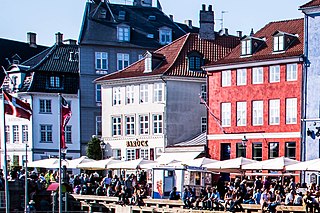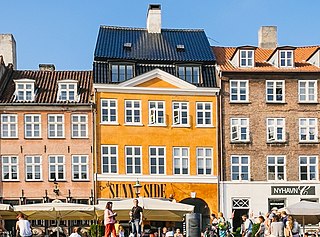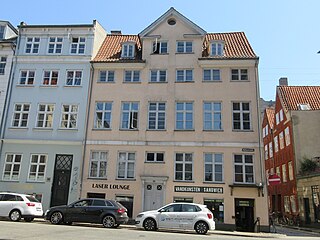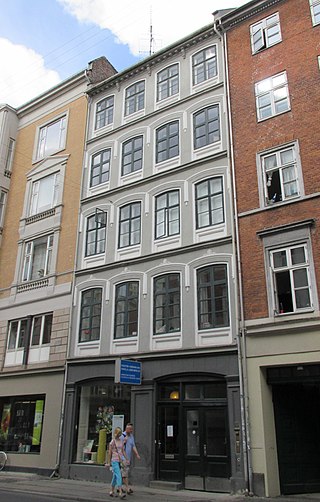
Baron Boltens Gård is a historic house at 8 Gothersgade in central Copenhagen, Denmark, as well as a passageway that connects Gothersgade to Store Kongensgade. In recent years the name has also referred to an entertainment cluster located at the same address.

The Cort Adeler House is a historic property located at Strandgade 22 in the Christianshavn neighbourhood of Copenhagen, Denmark. It takes its name from Admiral Cort Adeler who lived there for the last seven years of his life in the 17th century.

The Schottmann House Danish: is a historic property located at Strandgade 10 in the Christianshavn neighbourhood of Copenhagen, Denmark.

The Rhode House is a historic property located at the corner of Strandgade and Torvegade in the Christianshavn neighbourhood of central Copenhagen, Denmark.

Nyhavn 1 is an 18th-century property at the acute corner of Nyhavn with Store Strandstræde in central Copenhagen, Denmark. It was listed in the Danish registry of protected buildings and places in 1987. Notable former residents include actor and singer Peter Schram (1819–1895).

Nyhavn 31 is a listed property overlooking the Nyhavn canal in central Copenhagen, Denmark.

Nyhavn 41 is a listed property overlooking the Nyhavn canal in central Copenhagen, Denmark. For most of the 19th century, the property was owned by a family of sailmakers. The manufacturing of flags and compasses was also part of their trade. The building was listed in the Danish registry of protected buildings and places in 1918.

Ny Kongensgade 6 is a rococo-style property located at Ny Kongensgade 6 in central Copenhagen, Denmark. It was listed in the Danish registry of protected buildings and places in 1918. Notable former residents include the politician Christian Colbjørnsen, businessman Alfred Hage, politician Orla Lehmann, landowner Michael Treschow (1814–1901) and tobacco manufacturer Emilius Nobel.

Kronprinsessegade 20 is a Neoclassical property overlooking one of the entrances to Rosenborg Castle Garden in central Copenhagen, Denmark. It was listed on the Danish registry of protected buildings and places in 1945.

Kronprinsessegade 42 is a Neoclassical property overlooking Rosenborg Castle Garden in central Copenhagen, Denmark. The building was listed in the Danish registry of protected buildings and places in 1945. Notable former residents include businessman Hans Puggaard, military officer and carteographer Jacob H. Mansa (1797-1885), military officer H. C. G. F. Hedemann (1792-1859), editor and politician Hother Hage (1816-1873) and clergy and politician Ditlev Gothard Monrad (1811-1887). Sacred Heart Of Jesus Chapel, a Catholic chapel operated by Jesuits, was located in the building from 1878 to 1883.

The Lars Larsen House is a Neoclassical property located at the corner of Kronprinsessegade and Gothersgade in central Copenhagen, Denmark. It was constructed for ship-builder Lars Larsen shortly after the creation of Kronprinsessegade in the early 1800s. It was listed in the Danish registry of protected buildings and places in 1918. Larsen resided in the building until his death in 1844. Other notable former residents include former chiefs of police Andreas Christian Kierulff and Cosmus Bræstrup.
Store Strandstræde 7 is a small building located close to Kongens Nytorv central Copenhagen, Denmark. The building was listed on the Danish registry of protected buildings and places in 1989.

Overgaden Neden Vandet 33 is a residential property in the Christianshavn neighborhood of central Copenhagen, Denmark. It is one of three properties along with Christianshavn Canal that were built by anchor smith Hans Caspersen and are now known as the Hans Caspersen House, the other being Overgaden Oven Vandet 50 and Overgaden Neden Vandet 33. The building at Sankt Annæ Gade 4 is also associated with Caspersen. The building was listed on the Danish registry of protected buildings and places in 1918.

Rådhusstræde 17 is a Neoclassical property situated at the corner of Rådhusstræde and Magstræde, opposite Vandkunsten, in the Old Town of Copenhagen, Denmark. Dating from approximately 1800, it is one of the oldest buildings in the area. It was listed in the Danish registry of protected buildings and places in 1945.

Store Kongensgade 23 is a Neoclassical mixed-use building situated in Store Kongensgade in Copenhagen, Denmark. The building fronting the street was constructed by master mason Christian Olsen Aagaard in 1850. Aagaard had already constructed the adjacent building at No. 25 in 1837, whose ground floor hosted the Royal Court Pharmacy from 1950 until 1971. The two buildings share a courtyard on their rear. At the far end of the courtyard is a former silver factory constructed in 1887 by Bernhard Hertz according to his own design. The factory was decommissioned in 1942 and was later used as office space prior to being converted into apartments in 2018. Store Kongensgade 23 and the former silver factory were listed in the Danish registry of protected buildings and places in 1989. No. 25 is not listed.

Gothersgade 29 is a property with roots back to the late 17th century, but later increased in height twice and with a facade design dating from 1865, situated in Gothersgade, opposite Borgergade, in the Old Town of Copenhagen, Denmark. The building fronting the street is via a staircase on the rear attached to a half-timbered rear wing from before 1710. The complex was listed in the Danish registry of protected buildings and places in 1981.

Store Kannikestræde 15 is a Neoclassical property situated at the corner of Store Kannikestræde and Lille Kannikestræde in the Old Town of Copenhagen, Denmark. It was listed in the Danish registry of protected buildings and places in 1950. A plaque on the facade commemorates the fact that Peter Faber was a resident in the building when he wrote Højt fra træets grønne top in 1847. Other notable former residents include the landscape painter Thorald Læsøe, printmaker Søren Henrik Petersen (1788-1860), historian Caspar Frederik Wegener and illustrator Peter Christian Klæstrup.

Nyhavn 20 is a 17th-century building overlooking the Nyhavn canal in central Copenhagen, Denmark. It was listed in the Danish registry of protected buildings and places in 1945. The building houses a bar in the basement and a residential apartment on the upper floors. The facade features a relief of a fish above the main entrance, flanked by two reliefs of sailing ships.

Nyhavn 17 is a late 17th-century building situated at the corner of Nyhavn and Lille Strandstræde in central Copenhagen, Denmark. It was listed on the Danish registry of protected buildings and places in 1951. Tattoo-Ole, a tattoo shop located in the basement, claims to be the oldest still functioning tattoo shop in the world.

Købmagerhus is a commercial building situated at the corner of the shopping street Købmagergade and Silkegade in central Copenhagen, Denmark, built in 1898 to a Jugend style design by Chr. Hansen. A plaque on the facade commemorates that Niels Steensen was born on the site. Café de Grandeville, a café with live music, was originally located on the ground floor of the building. Its former premises were later converted into a cinema, Højbro Teatret, with just 251 seats, An earlier building on the site was built in 1731 for court jeweller Frederich Fabricius. It was later passed to his son and grandson, Christopher and Frederik Fabricius, both of whom also served as court jewellers. Copenhagen's first gentlemen's club, referred to variously as Fabricius' Club and "the club on Købmagergade", was based in the building.






















